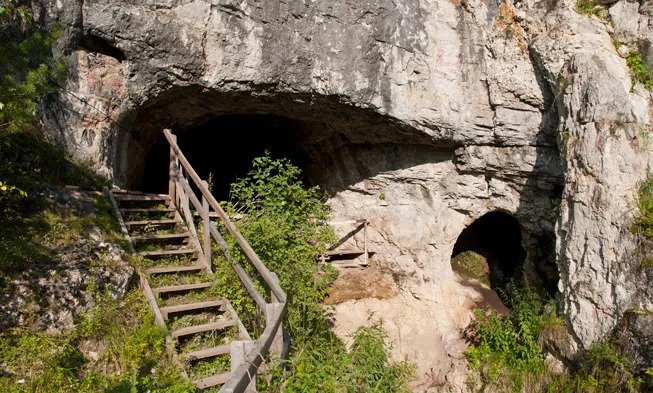90,000-year-old human hybrid found in ancient cave

90,000-year-old human hybrid found in ancient cave
It turns out blended families aren’t just the result of two previously established families coming together. A blended family could also be the result of two ancient human species procreating, for example, and creating an ancient human hybrid.

This is according to a genetic analysis of a bone fragment belonging to a young, potentially early-teenage girl who died about 90,000 years ago. The fragment, discovered in a cave in Siberia, marks the first time scientists have found evidence of an ancient human whose parents belonged to two extinct hominin groups: The girl’s mother was a Neanderthal and her father was a Denisovan.
“We knew from previous studies that Neandertals and Denisovans must have occasionally had children together,” Viviane Slon, a researcher at the Max Planck Institute for Evolutionary Anthropology and one of three first authors of the study, said in a statement. “But I never thought we would be so lucky as to find an actual offspring of the two groups.”
A match made in history

Until about 40,000 years ago, there were at least two groups of hominins present in Eurasia. These were the Neanderthals in the west and the Denisovans in the east. Neanderthals are fairly well known to us. We have a good idea of their overall build and even some insights into their culture through tool and habitat fragments.
Denisovans, however, we know very little about. Fossils for this extinct species of ancient humans are rare. The only samples we have all come from the same cave, Denisova Cave in Siberia, and these samples, discovered in 2008, amount to a finger and a few molars. Still, that little finger bone provided enough genetic material for researchers to identify the Denisovans as a distinct ancient human group in 2010.
The finger bone of the hybrid girl, dubbed Denny, came from this cave. Its mitochondrial DNA was sequenced in 2016, and this sequence was compared with those of other ancient humans. Based on these comparisons, researchers determined Denny’s mother was a Neanderthal since mitochondrial DNA is inherited from the mother. The identity of the father, however, was left a mystery.
In an August 2018 study, published in Nature, researchers sequenced the entire genome and then compared it with the genomes of three other hominins: a Neanderthal, a Denisovan and a modern-day human from Africa. About 40 per cent of the DNA was Neanderthal and another 40 per cent was Denisovan. Given the even split between the two groups, it seemed likely Denny was indeed the offspring of a Neanderthal mother and a Denisovan father.
While there was a possibility that Denny’s parents themselves belonged to a population of Neanderthal-Denisovan hybrids, researchers compared fragments of Denny’s DNA with those of the tested ancient humans to determine similarities and differences. In more than 40 per cent of the cases, one DNA fragment matched a Neanderthal while the other would match a Denisovan. This meant it was very likely each set of Denny’s chromosomes was supplied by a distinct human species.
What are the odds?

According to two new studies published in Nature, the odds are actually very likely. These studies both found evidence to support the idea that Neanderthals and Denisovans cohabitated inside Denisova Cave.
The first study conducted by Zenobia Jacobs and Richard Roberts of the University of Wollongong in Australia used stimulated luminescence to analyze 103 sediment deposits found inside the cave that spanned 280,000 years. From that analysis, they determined that Denisovans first lived inside the cave from 287,000 years to 55,000 years ago. Neanderthals joined them around 193,000 years ago and stayed until 97,000 years ago.
The second study organized by Katerina Douka from the Max Planck Institute for the Science of Human History in Germany instead examined thousands of artefacts and bone fragments from the cave using a variety of techniques, including radiocarbon dating and uranium-series dating. They determined the oldest Denisovan fossil dates back 195,000 years ago, and the youngest one is from 52,000 to 76,000 years ago. All the Neanderthal fossils they analyzed are from 80,000 to 140,000 years ago.
“The Douka paper is exciting because we knew that Neanderthals and Denisovans both used the Denisova cave and that the two groups interbred in or near there, but we didn’t know much about the length of time that each group frequented the cave or the length of time that the two groups overlapped in using the cave,” Sharon Browning, a research professor from the University of Washington who wasn’t involved in the new study, told Gizmodo.
Still up for debate
Even with these new findings, the topic of whether or not Neanderthals and Denisovans lived together in the cave is still debated among researchers.
Kelley Harris — a population geneticist at the University of Washington who has studied hybridization between early humans and Neanderthals — tells Nature such interactions between Neanderthals and Denisovans were probably fairly common given the lack of pure Denisovan bones available. As for why the two ancient humans stayed genetically distinct for a long period of time, Harris suggests the offspring may have been infertile or otherwise unable to successfully mate.
Svante Pääbo, a researcher from the Max Planck Institute for Evolutionary Anthropology who was involved in the study, believes meetings between the two ancient humans probably occurred only rarely. While their respective ranges overlapped some in the Altai Mountains, a mountain range where Russia, China, Mongolia and Kazakhstan border one another, those areas wouldn’t have had the populations necessary for many meetings to occur.
“I think any Neanderthal that lived west of the Urals would never ever meet a Denisovan in their life,” Pääbo tells Nature.
Based on variations in Denny’s DNA, researchers determined her Neanderthal mother was more closely related to a Neanderthal fossil found in Croatia, thousands of miles away from Denisova Cave, than to another Neanderthal found much closer to the cave. Complicating this is that the Croatian Neanderthal died a mere 55,000 years ago, while the Neanderthal near Denisova is around 120,000 years old. According to researchers, Denny’s mother must have either come with European Neanderthals travelling east and taken up residence there, or else a Neanderthal group left the Altai Mountains for Europe sometime after Denny was born.
Either way, Denny provides new and interesting insights into the behaviour of ancient humans, as well as a better genetic understanding of both human groups.